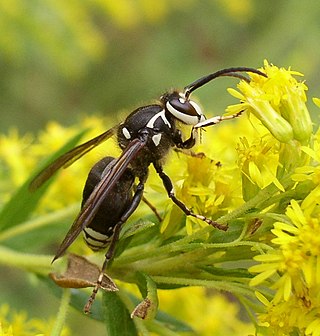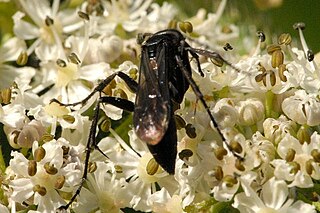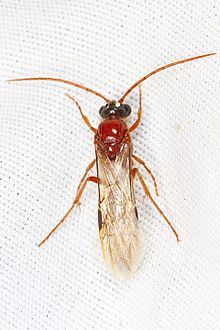
The Scoliidae, the scoliid wasps, are a family of wasps comprising about 560 species worldwide. They tend to be black, often marked with yellow or orange, and their wing tips are distinctively corrugated. Males are more slender and elongated than females, with significantly longer antennae, but the sexual dimorphism is not as apparent as in many of the Tiphiidae and Thynnidae.

Apocrita is a suborder of insects in the order Hymenoptera. It includes wasps, bees, and ants, and consists of many families. It contains the most advanced hymenopterans and is distinguished from Symphyta by the narrow "waist" (petiole) formed between the first two segments of the actual abdomen; the first abdominal segment is fused to the thorax, and is called the propodeum. Therefore, it is general practice, when discussing the body of an apocritan in a technical sense, to refer to the mesosoma and metasoma rather than the "thorax" and "abdomen", respectively. The evolution of a constricted waist was an important adaption for the parasitoid lifestyle of the ancestral apocritan, allowing more maneuverability of the female's ovipositor. The ovipositor either extends freely or is retracted, and may be developed into a stinger for both defense and paralyzing prey. Larvae are legless and blind, and either feed inside a host or in a nest cell provisioned by their mothers.

The superfamily Ichneumonoidea contains one extinct and three extant families, including the two largest families within Hymenoptera: Ichneumonidae and Braconidae. The group is thought to contain as many as 100,000 species, many of which have not yet been described. Like other parasitoid wasps, they were long placed in the "Parasitica", variously considered as an infraorder or an unranked clade, now known to be paraphyletic.

Vespoidea is a superfamily of wasps in the order Hymenoptera. Vespoidea includes wasps with a large variety of lifestyles including eusocial, social, and solitary habits, predators, scavengers, parasitoids, and some herbivores.

Parasitoid wasps are a large group of hymenopteran superfamilies, with all but the wood wasps (Orussoidea) being in the wasp-waisted Apocrita. As parasitoids, they lay their eggs on or in the bodies of other arthropods, sooner or later causing the death of these hosts. Different species specialise in hosts from different insect orders, most often Lepidoptera, though some select beetles, flies, or bugs; the spider wasps (Pompilidae) exclusively attack spiders.

Tiphia femorata, often known as a beetle-killing wasp or common tiphiid wasp, is a species of wasp belonging to the family Tiphiidae, subfamily Tiphiinae.

Anoplius nigerrimus is a species of spider wasp, or pompilid, and is the type species of the genus Anoplius.

Tiphia is a genus of wasps belonging to the family Tiphiidae subfamily Tiphiinae. They feed on soil-inhabiting scarab beetle larvae.

The Thynnidae are a family of large, solitary wasps whose larvae are almost universally parasitoids of various beetle larvae, especially those in the superfamily Scarabaeoidea. Until recently, the constituents of this family were classified in the family Tiphiidae, but multiple studies have independently confirmed that thynnids are a separate lineage.

Brachycistidinae is a subfamily of the flower wasp family Tiphiidae that contains 10 genera and 85 species, and which is confined to the Nearctic zoogeographic region.

Tiphiinae is one of the two subfamilies of the flower wasp family Tiphiidae, the other being the Nearctic Brachycistidinae. Tiphiinae is the larger of the two and has a worldwide distribution.

Myzinum maculatum is a species of wasp in the family Thynnidae. It is used as a biological control of turf grass pests.

Myzinum is a genus of wasps in the family Thynnidae. There are 63 species presently recognized in Myzinum. They measure 7–24 mm. They are found in meadows, fields, and lawns. They parasitize white grubs, including Phyllophaga. They are used as biological controls.

Myzinum obscurum is a species of wasp in the family Thynnidae. It is found in the Eastern United States.

Amiseginae is a subfamily of cuckoo wasps in the family Chrysididae. There are more than 30 genera and 150 described species in Amiseginae. The group occurs worldwide, and they are parasitoids of stick insect eggs (Phasmatodea). Females of some genera are flightless and resemble ants.
Methocha is a genus of parasitoid wasps in the family Thynnidae.

Methochinae is a small subfamily of solitary wasps in the family Thynnidae, whose larvae are parasitoids of various tiger beetle larvae.
Tiphia davidrajui is a species of wasp belonging to the family Tiphiidae, subfamily Tiphiinae. The species is named after a naturalist from Kerala Mr. David V. Raju.
Tiphia bijui is a species of wasp belonging to the family Tiphiidae, subfamily Tiphiinae. The species is named after an expert field assistant Mr. T. Biju, a Forest watcher at Aralam Wildlife Sanctuary.
Tiphia chareshi is a species of wasp belonging to the family Tiphiidae, subfamily Tiphiinae. The species is named after Mr.C.Charesh.
















